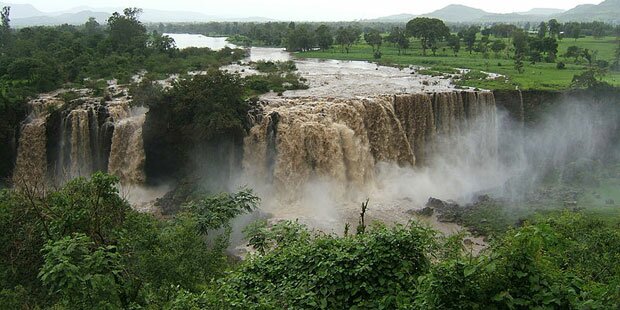When Egypt finishes its revolution off this summer with the preordained election of Field Marshall Abdelfattah al-Sisi to the presidency, one of his first tasks will be dealing with the unpleasant reality that two countries distant, up the Nile river, Ethiopia has spent the last three years of Egyptian domestic disorder building one of the highest dams in the world, the potently named Grand Ethiopian Renaissance Dam. Upon completion the structure will rear some 500 feet from the floor of the Blue Nile valley, produce as much as 6,000 megawatts of power for export to other African nations, and-in dry years- might significantly reduce the flow of water into Egypt and slash power generation at Egypt’s Aswan dam.
Predictably, the Renaissance Dam has become a nationalist rallying point for people in both countries, though it remains oddly uncontroversial in the country between them, Sudan(which already has three dams on the Nile upriver from Egypt). For Egyptians, who like to quote Herodotus that their country is ‘the gift of the Nile,’ the dam is seen in apocalyptic terms. For Ethiopians, it represents a rebirth of their country and perhaps a way to erase the shame of the hated images of the 1983 famine. Here, we attempt to capture the flavor of the issue in both countries:
‘ETHIOPIA IS EXPLOITING EGYPT’S FOCUS ON DOMESTIC PROBLEMS’
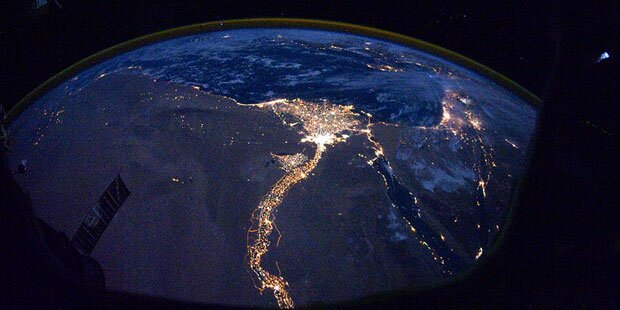 NASA satellite photograph of the Nile Delta. (Wikimedia Commons).
NASA satellite photograph of the Nile Delta. (Wikimedia Commons).
In Egypt’s Al Ahram Weekly, hydrogeologist Maghawry Shehata suggests that Egypt focus on slowing or stopping the Ethiopian dam while simultaneously making plans for increasing other supplies of water:
The Egyptian people are clamouring for tough measures against Ethiopia in response to its intransigence on the question of the Renaissance Dam that threatens the security of their most important resource, the Nile. Popular frustration mounted as Egyptian negotiators’ patience wore thin in defending Egypt’s water rights as confirmed and reconfirmed in every negotiating opportunity not only since 1981 but since the outset of the 20th century.
In the rounds in 1902, 1906 and 1929 it was established that Egypt had a right to an annual quota of Nile waters of 48 billion cubic metres. This quota remained unchanged until 1959 when the Egyptian-Sudanese Nile Waters Agreement added the quantity of water stored as the result of the construction of the High Dam (a quantity that had previously gone to waste). Thus, the Egyptian quota was brought up by 7.5 billion cubic metres to 55.5 billion cubic metres a year. This quota was subsequently reconfirmed in an agreement signed in 1993 between former president Hosni Mubarak and then Ethiopian prime minister Meles Zenawi who, additionally, reaffirmed his country’s commitment not to undertake any hydraulic works that might prevent Egypt from receiving its rightful share of Nile waters.
But there came a time when Ethiopia summoned the sufficient determination to shed all these tiresome historical obligations. Whereas once it was reluctant to participate in Nile water talks or was content to attend in an observer capacity, suddenly it was spearheading a Nile Basin countries initiative and lobbying other countries to back a new legal framework that would put paid to the principles of all previous Nile water agreements. The product was the Entebbe Agreement, which was signed by most upper riparian countries in 2010, but which Egypt strenuously opposed for the following reasons:
– It does not recognize the historic rights of Egypt and Sudan to Nile waters and, indeed, it makes no reference to them whatsoever.
– It does not recognize the principle of “current usages” as a potential alternative to “historic rights”.
– The upper riparian nations insist on applying the principle of water security to all countries.
– It discards the principle of prior notification as a guarantee against a hydraulic project or action that could be detrimental to other countries.
– The upper riparian nations insisted that amendments to any provisions of the agreement or its annexes could be approved by a majority instead of a unanimous vote.
– The insistence on the part of the upper riparian nations that any amendment to the agreement would have to be made after the creation of an overseeing commission, while Egypt’s position in 2010 was that changes needed to be made through negotiations and before ratification.
Then Ethiopia went ahead to put the Entebbe Agreement into effect unilaterally by inaugurating the construction of a series of dams on the Blue Nile and Atbara River basin. Unfortunately, Egypt did not raise any objections at the time, which gave Ethiopia tacit encourage to proceed with the construction of the Border Dam on the Blue Nile. It is noteworthy that Addis Ababa laid the cornerstone for this project, which has a reservoir capacity of 11 billion cubic meters a year, on 2 April 2011, which is to say around two months after Egypt’s 25 January Revolution. Clearly, the idea was to exploit the Egyptian focus on domestic concerns and developments at the time.
What is the solution to this precarious situation? What are the available alternatives?
Some are of the opinion that Egypt must escalate its cause against Ethiopia internationally. One option is international arbitration. But according to international law, this would require Ethiopia’s approval, which would obviously not be forthcoming. Addis has already made its position clear: it holds that construction of dams on its territory is a “domestic matter” and has demonstrated its indifference to the rights of downriver nations that might be harmed by such projects. A second option is to internationalize the problem in the manner of the question of Jerusalem or the question of Syria (an option that, in our opinion, would not serve Egypt’s best interests). A third alternative is to appeal to the UN (the General Assembly, the Security Council, the International Court of Justice).
All the foregoing options are feasible, on the condition that Egypt acts on them immediately, taking into consideration the following:
– Our strongest card by far is the report of the international tripartite technical committee on the Renaissance Dam.
– Ethiopia is bolstered by the 2010 Entebbe Agreement and the “majority” of six countries that signed it. Egypt must take action against this prejudicial agreement.
– The UN framework agreement on trans-boundary watercourse networks is elastic and its terms and provisions are open to different interpretations.
– The Nile water conventions signed between Britain, Italy, Egypt, Ethiopia and Sudan at various phases in history contain clear guarantees for Egypt’s water rights. These conventions are still valid under international treaty law.
Egypt has already taken too long to summon the resolve to appeal to UN bodies. The current circumstances of the country should not be cause for further delay, especially given that Ethiopia is using the current negotiating processes for no other purpose than to buy time in order to impose the de facto reality of the Renaissance Dam. By then, it would be too late, as Egypt will be staring at immeasurable catastrophe.
The second crucial question we must address is do we have the luxury to wait until that moment – which is imminent – that we are deprived of our water rights? Obviously the answer is no and we should turn our attention to a number of important water projects in the Upper Nile region.
Egypt should set into motion a strategic dialogue with South Sudan and Sudan to promote closer cooperation between the three countries in the pursuit of their water rights and needs. The close linkage between the two Sudans can facilitate Upper Nile water projects aimed at increasing the inflow into the White Nile, from which Nile branch Egypt currently receives very little. For example, of the approximately 45 billion cubic meters of water that flows into the Thala-Bahr Al-Ghazal basin, Egypt receives virtually nothing. It should be borne in mind, however, that such projects, described below, should not be seen as an alternative to Egypt’s historic rights but rather as a means to supplement or augment water revenues for the three countries, and indeed for other neighboring countries.
Shehata goes on to propose in detail such ecologically nightmarish scenarios as draining the vast wetlands of the Sudanese Sudd, and channeling water from Kenyan marshes downstream toward Egypt.
[…]
Meanwhile, as we pursue the above Upper Nile water projects, there are projects we can pursue at home that can furnish considerable quantities of water. Treatment of agricultural runoff water and other water purification projects can produce an additional five billion cubic metres a year. Another five billion could be gained by tapping subterranean water resources in the Western Desert in particular. Water conservation and management programs, combined with the further development of our irrigation and wastewater systems, and measures to prevent water pollution, would make an additional nine billion cubic meters of water available per year.
The abovementioned Upper Nile water projects are viable alternatives (as opposed to such madcap schemes as connecting the Congo with the Nile or digging two new rivers in the Western and Eastern desert). Plans and feasibility studies exist, there is interest among the countries concerned, and all stand to benefit.
Egypt should immediately set into motion the relevant processes of negotiations preparatory to putting such plans into effect. As for the water projects at home, they are long overdue. One cannot overstate the urgency of summoning the political will to carry them out.
– Maghawry Shehata
‘THE DAM WILL END THE PAIN OF WESTERN IMAGES OF FAMINE AFFLICTED WALKING SKELETONS’
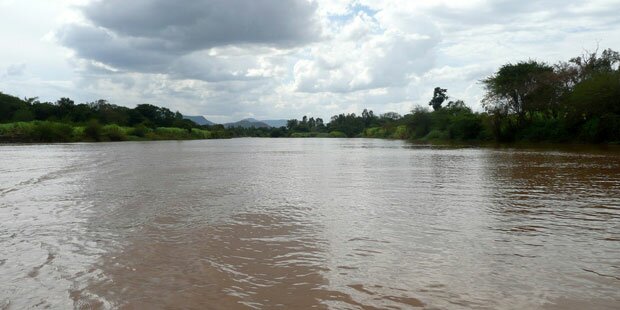 Blue Nile, near Bahir Dar, Ethiopia. Photo CC: Al and Marie.
Blue Nile, near Bahir Dar, Ethiopia. Photo CC: Al and Marie.
The Ethiopian press regularly decries perfidious Egyptian efforts to block financing for its dam, and hypocrisy given Egypt’s construction of its own massive Aswan dam in the last century. Portraying the project in Ethiopian nationalist terms is important, since it is being financed by public bonds: bureaucrats are encouraged to spend something like a sixth of their salaries purchasing dam bonds, for example. In The Reporter, Ethiopia’s Nurye Yassin writes:
The completion of the Aswan Dam on July 21, 1970 sent one critical message to Africa, and most importantly to Ethiopia. That is, the Aswan Dam was meant to divorce or delink Africa in general, and Ethiopia in particular, from the waters of the Nile. The Nasserites’ Dam proclaimed that Ethiopia was no longer a provider of fertility, sustenance and survival to Egypt. In other words, the radical young military officers voiced that the Aswan Dam was a game changer to make Lake Nasser the source of the Nile waters abandoning Lake Tana or their calculation amplified that the Aswan Dam would make Lake Nasser Lake Tana’s superior. Removing Ethiopia, the major contributor of the Nile, from the waters of the Nile was absolutely a mirage as their geopolitical calculation was against nature, humanity, history, geography and sustainability.
[…]
This principle was the unilateral, myopic and narrow entitlement of Egypt to the waters of the Nile anchoring the water security based on the delusory paternalistic hydro political hegemonic mindset. This kind of delusion has continued to the present day forsaking Ethiopia’s survival, water, and food insecurity.
[…]
The second chapter of the Aswan Dam to eternally control the Nile is the Toshka Canal. [A possibly ludicrous scheme to dump millions of tons of water into Egypt’s western desert, creating a ‘New Nile Valley.’] According to Ana Cascao, the 1997 President Mubarak’s unilateral move in reclaiming more lands in the North Sinai, the West Delta and the South Valley was to cement [Egypt’s] historic rights to the Nile waters in order to avoid other riparian countries from the development of the Nile. In 1998, the late Prime Minister, Meles Zenawi, questioned Egypt’s unsustainable [course]over the use of the Nile, saying that Egyptian politicians [were treating]the Nile as though they were a purely Egyptian affair rather than one concerning the states in the Nile basin. The Aswan Dam voices that Egypt is not ready to work with other riparian countries based on the cardinal principles of equality, fairness, coordination and shared benefit for the sustainable development of the Nile Basin.
[…]
One emblematic solid testimony of Ethiopia’s rebirth is the Grand Ethiopian Renaissance Dam project. It has awakened Ethiopians from their long slumber to heal the…pain of frequent famine, and tumultuous images of drought-stricken walking skeletons under the shade of the waters of the Nile River along with their brothers and sisters of upper and lower riparian countries. Drifting away from the dreary years of the passing ages, the people of Ethiopia are sowing their sweats and financing the project to turn the Nile from the sign of peril into the harbinger of Ethiopian Renaissance as well as African Rebirth.
When the GERD was launched in April, 2011 in Guba, Benishangul Gumuz region, the late Prime Minister, Meles Zenawi, reiterated that the Dam was the definition of Ethiopian Renaissance together with the revival of African Rebirth. He affirmed that the people of Ethiopia, the Horn as well as fellow African brothers and sisters would not be made victims of grinding poverty, ominous famine, senseless violence, frequent drought, heinous indignity, incessant suffering and excess of sorrow under the head waters of the Nile.
Indeed, the Dam will end Western portrayal of apocalyptic vision of the African experience as famine-overwhelmed, hopeless continent, socio-political traumatic field, and many other distressing words in their visualization of African past, present and future. Having comprehended Egypt’s abhorrence to equitable and constructive self-interest and its sustained attempts to undercut Ethiopia’s determination to secure funding overseas to accomplish the project, Ethiopians are committed that the project requires only themselves to make the Dam a reality as they are the descendants who crushed the invincibility of the white man’s sheer violence, power and psyche at Dogali, Adwa, Walwal, etc, as well as having made the architectural monuments of the gigantic sculptured obelisks of Axum, Tiya Tikil stones and the rock-hewn churches of Lalibela.
He also voiced that Ethiopia, the Horn and Africa would not be places where darkness and complete blankness engulf the hopes and aspirations of their peoples, stressing that the Dam would kindle and brighten the huts of the peoples of the Basin, Africa, and even beyond with affordable and cheap electricity prices. He added Ethiopia would commit its hydropower potentials to export to its neighbors. In fact, Ethiopia has lived up to its promises in supplying electricity to the eastern region of the continent. The proposed power trade of the GERD would further deepen and reinforce the mutually cooperative partnership and fast track the regional economic communities to attain the integration, unity and solidarity of the people of Africa.
[…]
At the end of his remarks, Meles Zenawi reaffirmed that we not only have a plan, but we also have the capacity to assert our rights through our savings and sales of bonds. He pointed out that Ethiopians were devoted to use the Nile waters in their fight against none other than poverty. He lastly called for all Nile Basin countries to come to the new route of cooperation and partnership, noting that the Dam will also stand as an expression of our commitment to the benefits of all the peoples of the Basin.
It is now very clear that the Aswan Dam shows Egypt’s hydro political dexterity and geopolitical ploy to downplay the needs of the peoples of up-stream countries. As a result, underdevelopment, chronic conflicts, economic marginalization, disease, hopelessness, political decadence, serious famines and other social ills engulfed the Nile Basin region and afflicted the lives of many peoples in the 20th century. Happily, GERD has come to correct the basin’s failure, the injustice and the flaws of the policies of Egypt. The GERD offers another alternative – the mutually cooperative partnership over the development, management and utilization of the Nile – to fairly and equitably channel the waters of the river for the mutual development and transformation of the Nile Valley region and for the realization of the priorities of African Renaissance.
– Nurye Yassin
‘EGYPTIAN ATTEMPTS TO CONTROL EVERY ACTIVITY ON THE NILE ARE AS OLD AS HISTORY’
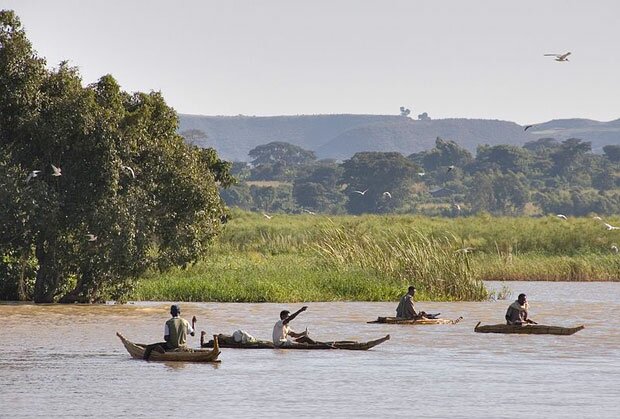 Fishermen, Lake Tana, Ethiopia. Photo CC: Alan.
Fishermen, Lake Tana, Ethiopia. Photo CC: Alan.
Would Egypt go to war over a Nile dam? Ethiopians seem to regard this as a thin possibility given the distances and the vast disparity in military readiness between the two countries. But as Neamin Ashenafi points out in The Reporter, a 2013 Egyptian cabinet meeting which was ‘accidentally’ broadcast on live television discussed the possibility of sabotaging the dam or arming Somali militants to attack Ethiopia. Moreover, he points out, Egypt did invade Ethiopia once in an attempt to gain control over the Nile-back in the 1870s.
After Ethiopia announced the construction of the Grand Ethiopian Renaissance Dam (GERD) three years ago many Egyptians … considered the construction of the dam a threat to the life and wellbeing of their country.
[…]
The activities and concerns of Egypt to halt the construction of this dam is multi faceted and includes diplomatic efforts to internationalize the issue and, in its worst, scenarios plans to sabotage the project by using different mechanisms. This plan however, is not a new one. Leaders of the country both in the past and currently are putting military action on the table to hamper Ethiopia from constructing a dam over the river Nile and not to use the river without Egypt’s permission.
In a very recent incident in June of 2013, it was reported that Egyptian politicians were reportedly caught proposing anti-Ethiopia sabotage plans in a closed door meeting which was broadcast live on air without their knowledge (it is still not clear if the meeting was broadcast live on air deliberately or as the politicians say, without their knowledge) Whatever the case, a meeting chaired by the toppled Egyptian president, Mohammed Morsi, shows that Egypt may consider the issue of sabotage to halt the Ethiopian power project on the table.
[…]
Though the movement is reaching its peak, Egyptian interest to control every activity over the river Nile is as old as history itself. Among Egyptians, it was widely believed that the Emperor of Ethiopia could shut off the waters of the Nile as one would shut off an outlet.
Daniel Kendie (Ph.D.) Associate Professor of History, in his article entitled “Egypt and the Hydro-Politics of the Blue Nile River,” argued that in more modern times, especially in the 18th and 19th century, Egypt’s invasion and final conquest of the Sudan was largely motivated by its desire to secure control over the entire Nile system. Muhammed Ali (1769-1849), for instance, felt that the security and prosperity of Egypt could only be assured fully by extending conquests to those Ethiopian provinces from which Egypt received its great reserves of water.
The objective of such a conquest was designed to impose Egypt’s will on Ethiopia, and either to occupy it or to force it to give up the Lake Tana area.
And hence, the Egyptian conquest of the Sudan in 1820 served as a stepping-stone to the increased presence of Egyptian soldiers in the western frontiers of Ethiopia.
[…]
Egypt’s foreign policy has, to a significant degree, been shaped by the hydro-politics of the Nile. It is predicated upon the premise that Egypt should be strong enough either to dominate Ethiopia or to create the conditions to prevent Ethiopia from building dams on the Blue Nile.
With that end in mind, Egypt controlled the port of Massawa from 1865 to 1885 and occupied parts of present-day northwestern Eritrea from 1872-1884 with a view to using these areas as a basis for military operations against the rest of Ethiopia.
As noted in many historical documents, Egypt’s military ambitions were brought to a halt by its disastrous defeats at Gura and Gundet.
– Neamin Ashenafi
‘INTERNATIONAL RIVERS NETWORK ACTIVISTS AT THEIR COMFORTABLE CALIFORNIA OFFCE HAVE NEVER EXPERIENCED REAL THIRST!’
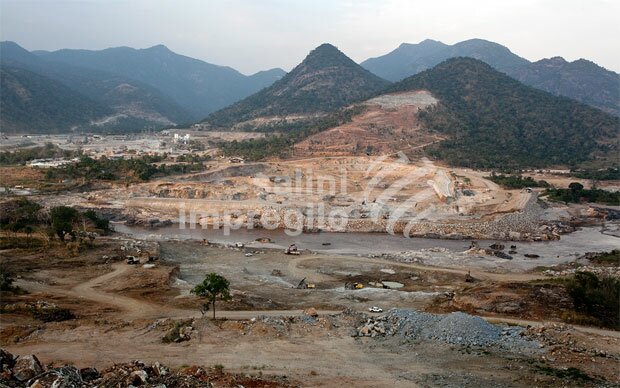 Grand Renaissance Dam construction site, photo courtesy contructor Salini Impregilo..
Grand Renaissance Dam construction site, photo courtesy contructor Salini Impregilo..
Particularly hated by the Ethiopian press: the small Berkeley-based environmental organization called International Rivers Network, widely suspected in Addis Ababa of being secretly financed by Egypt. Here, a panel of Ethiopian experts attacks Internatioanl Rivers’ latest critical assessment of the Renaissance Dam:
For so many years now the IRN, International River Network, this self-appointed “guardian” of all rivers of the world, has been leaving no stone unturned in its effort to subvert Ethiopia’s efforts to develop its water resources and lift its vast and growing population out of poverty. This is manifested most glaringly in its incessant negative campaign against the Grand Ethiopian Renaissance Dam (GERD), initiated from the very first days when the idea of water resources development on the Abbay was floated, including even through the Nile Basin Initiative.
Apart from being amused, the NPOE so far had chosen to ignore IRN’s anti-Ethiopia lobbying which is driven by an ideological, if not fanatical-messianic mission to “protect [the world’s]rivers and … to stop destructive dams”. IRN is accuser, police, judge and jury all rolled into one. IRN determines for countries, particularly for developing and poor countries like Ethiopia, how to do water resources development projects the “right” way. For these “backward” countries, IRN is the high priest that communes with God the Almighty and determines what is the most environmentally appropriate, most efficient and economical, and most beneficial for local, national and regional not only flora and fauna but also human communities too. What paternalism!!
Until now we did not find it worthwhile to get into polemics with what we thought were basically misinformed and misguided IRN campaign. That is, until now. But now we are compelled to revise our stance toward these people. The straw that broke the camel’s back, so to speak, happened on March 31, 2014 when IRN posted on its website a piece entitled ” GERD panel of Experts Report: Big Questions Remain” in which IRN explicitly called on Ethiopia to halt the construction of GERD!!
It would be unconscionable for us as professional Ethiopians well versed with and advising on GERD related issues to keep on looking at these people with bemusement and indifference when they peddle, clearly siding with Egypt, distorted, unsubstantiated and hostile mercenary propaganda against GERD and the Ethiopian people. It would take pages and pages to show the intense partisan nature of IRN in its entirety. However, the next few paragraphs suffice to illustrate our concern and to show a clear pattern of IRN’s growing hostility toward Ethiopia. IRN’s campaign against GERD and Ethiopia happened in four overlapping but discernable distinct stages:
Stage 1: Dissuade them!
True to its anti-dam creed, IRN did its best to discourage the idea of dam building in Ethiopia in the first place. IRN put forth whatever argument to dissuade decision makers. Arguments included those dams of a GERD scale would drain the national budget, would distort priorities, would be difficult to fund, etc. Here is one quote from their website:
“The US$5 billion scheme [GERD] is out of scale for such a poor country; the current cost estimate equals the country’s entire annual budget. The costly project is monopolizing government funding for the energy sector, leaving many worthy projects that would directly address the nation’s high energy poverty underfunded.”
IRN, in a piece titled “A Tale of Two Dams: Comparing Ethiopia’s Grand Renaissance to Hoover” and “drawing lessons” from ‘follies’ of the Hoover Dam, offered advice to Ethiopia: do not repeat USA’s mistakes! We will not go into the contentious and invalid arguments, to say the least, put forward and better ignore IRN’s unsolicited advice. What is interesting is the poison that is wrapped in the package of IRN’s advice. Read on:
“Ethiopian engineers recently compared the Grand Renaissance Dam to Hoover as a project that can lift a struggling nation out of poverty, and a project whose accomplishments will go down in history. Yet the darker lessons from Hoover’s long history might be equally relevant for Ethiopia to review. Consider: The mega dam model is a dinosaur. Ethiopia would be better off leapfrogging over it to a more modern and efficient system, and find less provocative ways to assert its interests over the Nile waters” (emphasis added)
IRN’s message is not only that Ethiopia should not build big dams. The message is also that Ethiopia should stop being “provocative”. IRN advises Ethiopia to assert its right other than through being provocative i.e. other than through deciding to build GERD. To IRN, Ethiopia’s decision to build GERD is provocation!! So much, for IRN’s “advice”!
When the above tactics fail, IRN, referring to an expert (which it conveniently pluralizes), sheds crocodile tears by stating that Ethiopia is wasting its scarce resources on oversized projects like the Grand Ethiopian Renaissance Dam. Here is another quote from their website:
“Ethiopia’s Biggest Dam Oversized, Experts Say Date: Thursday, September 5, 2013.
In May, Ethiopia diverted the Blue Nile to begin building its largest dam project to date, the 6,000 MW Grand Ethiopia Renaissance Dam (GERD) – a move that angered Egypt, which fears its water supply will shrink over the many years it will take to fill the huge reservoir. Besides the tensions this huge project is causing politically, there is growing concern that the dam will not produce nearly as much power as it has been designed to.” (Emphasis added)
Again, IRN never loses opportunity to lobby for its Egyptian paymasters. Not only does IRN talk about the “oversize” of GERD, but also about the Egyptians’ negative emotions over GERD: anger and fear!
In yet another alarmist piece related to GERD, IRN bemoaning “Ethiopia’s Dam Boom”, fabricates outrageous white lies:
“International Rivers is monitoring dam planning in Ethiopia, working to keep international donors from investing in the worst projects on the drawing boards, and sharing knowledge about better alternatives and the legacy of Ethiopia’s past dams with international civil society.
Water for irrigation from large reservoirs is mostly earmarked for large-scale agricultural producers – and increasingly, for foreign agricultural developments taking advantage of a government-sponsored land leasing program.
Alas, IRN has nothing factual to show, in any of the GERD plans, to substantiate its claim that GERD is an irrigation project!! We should not dwell on this any longer for the facts speak for themselves.
Stage 2: Smear campaign
When its dissuasion tactic failed and GERD implementation proceeded on with earnest, IRN had to embark on what we may term its Stage 2 tactics: a smear campaign. Here IRN does all it can to find any fault – big or small, real or imagined- with GERD in a bid to discredit it in the eyes of the world, particularly funders. Here is one quote from an IRN piece of 06/07/2013 with an eye catching alarmist title “Why has the Nile become a Battleground?:
[…]
The dam poses a number of risks to…downstream neighbors; one reason for the growing tension is that these risks have not been properly analyzed. Egypt has virtually no other sources of water for its people, and is already making do with less water per person than the international average. By at least one estimate, the Grand Renaissance reservoir could evaporate 3bn cubic meters of water a year – three times Egypt’s annual rainfall, and enough to meet the basic needs of up to half a million people. The reservoir could take 3-5 years to fill, reducing Egypt’s water supply by up to 25%.
It will evaporate 3 BMC of water annually, equivalent to a non-existent Egyptian rainfall! IRN is making this fabricated statement, while keeping mum on the 10-15 BMC annual evaporation loss the Egyptian High Aswan Dam is causing in the middle of the Sahara Desert! How “fair” of IRN!!
The report goes on in detail, attempting to refute most of International Rivers’ claims about the dam’s environmental and human impact.
[…]
Conclusion
It is obvious that in its desperation the IRN has been forced to come out and show its true color: a proxy for Egypt masquerading as an international environmental group fighting for the health of rivers!!
In all its ranting does IRN feel obliged, even if to feign decency, neutrality and disinterest, to mention Ethiopia’s need and desperation.
[…]
Why does IRN dwell and fight exclusively for Egyptian interests, harps on their real or imagined and fabricated fears, while not uttering a single word about the waste incurred via the High Aswan Dam (HAD), via the Toshka project, etc?
…
IRN has no boundaries of shame. It accuses the IPOE members of ‘keeping silent”! Should every sensible human being on the face of the earth turn into a corrupt IRN partisan activist?
The IRN! The IRN that resides in California, USA, whose activists never have endured or experienced what it means to go thirsty or hungry for days; the IRN, if it had all the power to do so would have halted all water resources development projects all over the developing world.
GERD National Panel of Experts.
05 May 2014




































